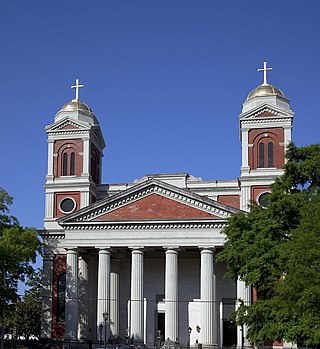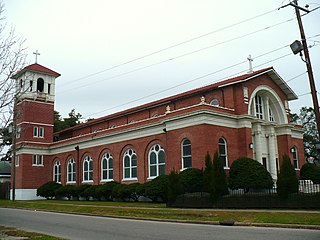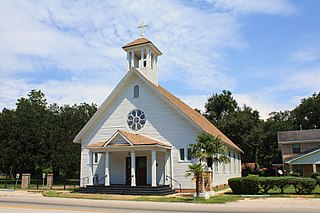Related Research Articles

Mobile is a city and the county seat of Mobile County, Alabama, United States. The population was 187,041 at the 2020 census. After a successful vote to annex areas west of the city limits in July 2023, Mobile's population increased to 204,689 residents, making it the second-most populous city in Alabama, after Huntsville. Mobile is the principal municipality of the Mobile metropolitan area, a region of 430,197 residents composed of Mobile and Washington counties; it is the third-largest metropolitan area in the state.

Mobile Bay is a shallow inlet of the Gulf of Mexico, lying within the state of Alabama in the United States. Its mouth is formed by the Fort Morgan Peninsula on the eastern side and Dauphin Island, a barrier island on the western side. The Mobile River and Tensaw River empty into the northern end of the bay, making it an estuary. Several smaller rivers also empty into the bay: Dog River, Deer River, and Fowl River on the western side of the bay, and Fish River on the eastern side. Mobile Bay is the fourth-largest estuary in the United States with a discharge of 62,000 cubic feet (1,800 m3) of water per second. Annually, and often several times during the summer months, the fish and crustaceans will swarm the shallow coastline and shore of the bay. This event, appropriately named a jubilee, draws a large crowd because of the abundance of fresh, easily caught seafood.

France began colonizing the Americas in the 16th century and continued into the following centuries as it established a colonial empire in the Western Hemisphere. France established colonies in much of eastern North America, on several Caribbean islands, and in South America. Most colonies were developed to export products such as fish, rice, sugar, and furs.

Former names: Apostolic Vicariate of Alabama and the Floridas (1825-1829), Diocese of Mobile, Diocese of Mobile-Birmingham (1954-1969).

The Cathedral Basilica of the Immaculate Conception is a cathedral serving Roman Catholics in the U.S. city of Mobile, Alabama. It is the seat of the Archbishop of the Roman Catholic Archdiocese of Mobile. The cathedral is named for Mary, mother of Jesus, under her title, Our Lady of the Immaculate Conception. It is listed on the National Register of Historic Places as a contributing property to the Church Street East Historic District and Lower Dauphin Street Historic District and is listed on the Historic Roman Catholic Properties in Mobile Multiple Property Submission
The sieur de Sauvolle, known for certainty only by his surname, was the first governor of the French territory of Louisiana. He accompanied the brothers Iberville and Bienville on their first voyage to Louisiana in 1699 and their explorations inland. On May 2, 1699, he was appointed commander of the new Fort Maurepas, and in January 1700 he became the territory's governor.

The Bankhead Tunnel, formally the John H. Bankhead Tunnel, is a road tunnel in Mobile, Alabama that carries Government Street under the Mobile River from Blakeley Island to the downtown Mobile business district. It is named for John H. Bankhead, an Alabama politician and U.S. Senator who was also the grandfather of actress Tallulah Bankhead. It, like the larger George Wallace Tunnel a few blocks downriver from it, was constructed in Mobile at the shipyards of the Alabama Drydock and Shipbuilding Company (ADDSCO), from 1938-1940. The eastern end of the Bankhead Tunnel features a large "flood door" that can be closed to prevent water from Mobile Bay flooding the tunnel during surges from hurricanes or tropical storms. It was added to the Alabama Register of Landmarks and Heritage on January 25, 1977.

Brookley Air Force Base is a former United States Air Force base located in Mobile, Alabama. After it closed in 1969, it became what is now known as the Mobile Aeroplex at Brookley.

Mobile was founded as the capital of colonial French Louisiana in 1702 and remained a part of New France for over 60 years. During 1720, when France warred with Spain, Mobile was on the battlefront, so the capital moved west to Biloxi. In 1763, Britain took control of the colony following their victory in the Seven Years' War. During the American Revolutionary War, the Spanish captured Mobile and retained it by the terms of the Treaty of Paris in 1783.

Bienville Square is a historic city park in the center of downtown Mobile, Alabama. Bienville Square was named for Mobile's founder, Jean-Baptiste Le Moyne, Sieur de Bienville. It takes up the entire block bordered by the streets of Dauphin, Saint Joseph, Saint Francis, and North Conception.

The Mobile Public Library is a public library system primarily serving Mobile County, Alabama. The system is a department of the city of Mobile and receives funding from Mobile County and the city of Saraland.

Catholic Cemetery, formerly known as the Stone Street Cemetery, is a historic 150-acre (61 ha) cemetery located in Mobile, Alabama. It was established in 1848 by Michael Portier, a native of Montbrison, France and the first Roman Catholic Bishop of Mobile. The cemetery contains roughly 18,000 burials and has plots dedicated to various Roman Catholic religious institutes, including the Brothers of the Sacred Heart, Daughters of Charity, Little Sisters of the Poor, and Sisters of Mercy. It was placed on the National Register of Historic Places on July 3, 1991, as a part of the Historic Roman Catholic Properties in Mobile Multiple Property Submission.

Saint Joseph's Roman Catholic Church was a historic Roman Catholic church building in Mobile, Alabama, United States. It served as the parish church for St. Joseph's Parish in the Roman Catholic Archdiocese of Mobile.

St. Vincent de Paul Catholic Church, now known as Prince of Peace Catholic Church, is a historic Catholic church in Mobile, Alabama. It was designed by a local architect, James H. Hutchisson, in the Gothic Revival style.

Saint Matthew's Catholic Church is a historic Roman Catholic church building in Mobile, Alabama. It was built in the Mediterranean Revival style in 1913, shortly after its parish was founded. The building was placed on the National Register of Historic Places on July 3, 1991, as a part of the Historic Roman Catholic Properties in Mobile Multiple Property Submission.

This is a list of the National Register of Historic Places listings in Mobile, Alabama.

Saint Francis Xavier Roman Catholic Church, also known as St. Francis Xavier Church, is a historic Roman Catholic church building in the Toulminville neighborhood of Mobile, Alabama, United States. It serves as the parish church for St. Francis Xavier Parish in the Roman Catholic Archdiocese of Mobile. St. Francis Xavier Parish was established in 1868. The vernacular style building was completed in 1916, replacing a previous structure destroyed in a hurricane. It was placed on the National Register of Historic Places on July 3, 1991, as part of the Historic Roman Catholic Properties in Mobile Multiple Property Submission.

The Protestant Children's Home, also known as the Protestant Orphans' Asylum, is a historic orphanage building in Mobile, Alabama, United States. It was placed on the National Register of Historic Places on June 18, 1973.
In 2015 the building was leased to the Infant Mystics society which began using it as a meeting lodge, renaming the place Cotton Hall.
The 19th Century Spring Hill Neighborhood Thematic Resource is a multiple property submission of buildings that were listed together on the National Register of Historic Places. It covers eight properties in the Spring Hill neighborhood of Mobile, Alabama, all built during the mid-19th century.
The Spanish Revival Residences in Mobile Multiple Property Submission is a multiple property submission of buildings that were listed together on the National Register of Historic Places as some of the best remaining examples in Mobile, Alabama of houses built in the Spanish Colonial Revival style. It covers ten properties.
References
- 1 2 "Historic Roman Catholic Properties in Mobile MPS". "National Register Information System". Retrieved October 26, 2011.
- 1 2 Higginbotham, Jay. Old Mobile: Fort Louis de la Louisiane, 1702-1711, pages 106–107. Museum of the City of Mobile, 1977. ISBN 0-914334-03-4.
- ↑ Boyle, Charles J. (2004). Gleanings from the Spring Hill College Archives. Mobile: Friends of the Spring Hill College Library. ISBN 1-887650-24-5.
- ↑ Thomason, Michael. Mobile : the new history of Alabama's first city, page 89. Tuscaloosa: University of Alabama Press, 2001. ISBN 0-8173-1065-7
- ↑ Thomason, Michael. Mobile : the new history of Alabama's first city, pages 213–217. Tuscaloosa: University of Alabama Press, 2001. ISBN 0-8173-1065-7
